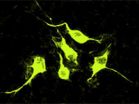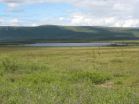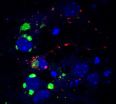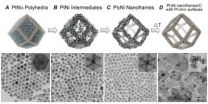Bison ready for new pastures?
Quarantine protocol successfully used to demonstrate brucellosis-free bison from infected herds
2014-02-27
(Press-News.org) A new study from the USDA Animal and Plant Health Inspection Services (APHIS) and the Wildlife Conservation Society (WCS) demonstrates that it is possible to qualify bison coming from an infected herd as free of brucellosis using quarantine procedures. These bison can then be used to seed conservation herds in other landscapes without the threat of spreading the disease.
In response to Interagency Bison Management Plan (IBMP) guidelines on federal and state bison management actions, the USDA, APHIS Brucellosis Eradication: Uniform Methods and Rules protocol for the quarantine of bison was tested to see if it could successfully be used to qualify the animals as brucellosis-free.
Results of the study indicated that it is feasible to take young bison from an infected population and, using the approved quarantine protocol published as a Federal Uniform Method and Rule (UM &R), qualify them as brucellosis-free in less than three years.
Between 2005 and 2008, more than 200 bison calves of Yellowstone National Park origin were transported to a quarantine facility at Corwin Springs Montana, just outside Yellowstone National Park. During the study, blood samples were collected from the animals every 30-45 days and tested for brucellosis. Those animals that tested positive were euthanized and those remaining were tested until all had two consecutive negative tests. Since the primary mode of brucellosis transmission is via abortion and birthing events, all animals testing negative were held until they produced their first calf and showed no evidence of the disease in newborn calves, birth fluids, or blood. At that point, the bison were considered brucellosis-free.
The study showed that all bison continued to be brucellosis-free over the course of the seven-year study after the initial screening period and through several calving cycles. No evidence of brucellosis was found in either newborn calves or their mothers.
"The results of this study indicate that under the right conditions, there is an opportunity to produce live brucellosis-free bison from even a herd with a large number of infected animals like the one in Yellowstone National Park," said Dr. Jack Rhyan, APHIS Veterinary Officer. "Additionally, this study was a great example of the benefits to be gained from several agencies pooling resources and expertise to research the critical issue of brucellosis in wildlife."
The authors of the study note that agencies charged with the management of bison agree that capture and relocation of bison to other suitable habitats would be an appropriate alternative to the lethal removal of bison that exceed population objectives for Yellowstone National Park, as defined by the IMBP. The UM &R protocol could facilitate such relocation by demonstrating animals are disease-free and would not transmit brucellosis to cattle or other animals.
At the same time, a movement to ecologically restore bison to large landscapes is gaining momentum throughout the United States and Canada, and brucellosis-free bison may be needed to seed those landscapes. In particular, the genetics of Yellowstone bison are important because they are known to be free of cattle genes and represent bison that existed on the Great Plains for thousands of years.
WCS Bison Project Coordinator Keith Aune said, "This study represents an important milestone in bison conservation and these research findings enable us to practice genetic rescue from brucellosis infected bison herds. The Yellowstone animals passing through this system of testing are critical to conserving the diversity of the bison genome over the long term. We've also learned a great deal about brucellosis blood testing and how to better interpret results when screening animals for this disease. It is our hope that several satellite herds of Yellowstone bison can be assembled from the animals that graduate through this quarantine process."
INFORMATION:
The study, "Feasibility of quarantine procedures of bison (Bison bison) calves from Yellowstone National Park for conservation of brucellosis-free bison," appears in the March 1st edition (now online) of the Journal of the American Veterinary Medical Association. Authors include P. Ryan Clarke, D.V.M., M.P.H.; Rebecca K. Frey, M.S.; Jack C. Rhyan, D.V.M., M.S.; Matt P. McCollum, M.S.; Pauline Nol, D.V.M., M.D.,Ph.D.; and Keith Aune, M.S..
For a link to the paper's abstract, go to: http://avmajournals.avma.org/doi/abs/10.2460/javma.244.5.588
Funding for this study was provided by USDA APHIS, Montana Fish Wildlife and Parks and Montana Department of Livestock.
ELSE PRESS RELEASES FROM THIS DATE:
10,000 years on the Bering land bridge
2014-02-27
SALT LAKE CITY, Feb. 27, 2014 – Genetic and environmental evidence indicates that after the ancestors of Native Americans left Asia, they spent 10,000 years in shrubby lowlands on a broad land bridge that once linked Siberia and Alaska. Archaeological evidence is lacking because it drowned beneath the Bering Sea when sea levels rose.
University of Utah anthropologist Dennis O'Rourke and two colleagues make that argument in the Friday, Feb. 28, issue of the journal Science. They seek to reconcile existing genetic and paleoenvironmental evidence for human habitation on ...
A bird's eye view of cellular RNAs
2014-02-27
BOSTON -- In biology, as in real estate, location matters. Working copies of active genes -- called messenger RNAs or mRNAs -- are positioned strategically throughout living tissues, and their location often helps regulate how cells and tissues grow and develop. But to analyze many mRNAs simultaneously, scientists have had to grind cells to a pulp, which left them no good way to pinpoint where those mRNAs sat within the cell.
Now a team at the Wyss Institute of Biologically Inspired Engineering at Harvard University and Harvard Medical School, in collaboration with ...
Scientists uncover trigger for most common form of intellectual disability and autism
2014-02-27
NEW YORK (February 27, 2014) -- A new study led by Weill Cornell Medical College scientists shows that the most common genetic form of mental retardation and autism occurs because of a mechanism that shuts off the gene associated with the disease. The findings, published today in Science, also show that a drug that blocks this silencing mechanism can prevent fragile X syndrome – suggesting similar therapy is possible for 20 other diseases that range from mental retardation to multisystem failure.
Fragile X syndrome occurs mostly in boys, causing intellectual disability ...
CU-led study says Bering Land Bridge a long-term refuge for early Americans
2014-02-27
A new study led by the University of Colorado Boulder bolsters the theory that the first Americans, who are believed to have come over from northeast Asia during the last ice age, may have been isolated on the Bering Land Bridge for thousands of years before spreading throughout the Americas.
The theory, now known as the "Beringia Standstill," was first proposed in 1997 by two Latin American geneticists and refined in 2007 by a team led by the University of Tartu in Estonia that sampled mitrochondrial DNA from more than 600 Native Americans. The researchers found that ...
Fossils offer new clues into Native American's 'journey' and how they survived the last Ice Age
2014-02-27
Researchers have discovered how Native Americans may have survived the last Ice Age after splitting from their Asian relatives 25,000 years ago.
Academics at Royal Holloway, University of London, and the Universities of Colorado and Utah have analysed fossils which revealed that the ancestors of Native Americans may have set up home in a region between Siberia and Alaska which contained woody plants that they could use to make fires. The discovery breaks new ground as until now no-one had any idea of where the native Americans spent the next 10,000 years before they appeared ...
Researchers reveal the dual role of brain glycogen
2014-02-27
In 2007, in an article published in Nature Neuroscience, scientists at the Institute for Research in Biomedicine (IRB Barcelona) headed by Joan Guinovart, an authority on glycogen metabolism, reported that in Lafora Disease (LD), a rare and fatal neurodegenerative condition that affects adolescents, neurons die as a result of the accumulation of glycogen—chains of glucose. They went on to propose that this accumulation is the root cause of this disease.
The breakthrough of this paper was two-sided: first, the researchers established a possible cause of LD and therefore ...
UCSB study reveals evolution at work
2014-02-27
New research by UC Santa Barbara's Kenneth S. Kosik, Harriman Professor of Neuroscience, reveals some very unique evolutionary innovations in the primate brain.
In a study published online today in the journal Neuron, Kosik and colleagues describe the role of microRNAs — so named because they contain only 22 nucleotides — in a portion of the brain called the outer subventricular zone (OSVZ). These microRNAs belong to a special category of noncoding genes, which prevent the formation of proteins.
"It's microRNAs that provide the wiring diagram, dictating which genes ...
Big step for next-generation fuel cells and electrolyzers
2014-02-27
A big step in the development of next-generation fuel cells and water-alkali electrolyzers has been achieved with the discovery of a new class of bimetallic nanocatalysts that are an order of magnitude higher in activity than the target set by the U.S. Department of Energy (DOE) for 2017. The new catalysts, hollow polyhedral nanoframes of platinum and nickel, feature a three-dimensional catalytic surface activity that makes them significantly more efficient and far less expensive than the best platinum catalysts used in today's fuel cells and alkaline electrolyzers. This ...
Fossilized human feces from 14th century contain antibiotic resistance genes
2014-02-27
A team of French investigators has discovered viruses containing genes for antibiotic resistance in a fossilized fecal sample from 14th century Belgium, long before antibiotics were used in medicine. They publish their findings ahead of print in the journal Applied and Environmental Microbiology.
"This is the first paper to analyze an ancient DNA viral metagenome," says Rebecca Vega Thurber of Oregon State University, Corvallis, who was not involved in the research.
The viruses in the fecal sample are phages, which are viruses that infect bacteria, rather than infecting ...
Physicians' stethoscopes more contaminated than palms of their hands
2014-02-27
VIDEO:
A comparative analysis shows that stethoscope diaphragms are more contaminated than the physician's own thenar eminence (group of muscles in the palm of the hand) following a physical examination.
Click here for more information.
Rochester, MN, February 27, 2014 – Although healthcare workers' hands are the main source of bacterial transmission in hospitals, physicians' stethoscopes appear to play a role. To explore this question, investigators at the University of ...
LAST 30 PRESS RELEASES:
Making lighter work of calculating fluid and heat flow
Normalizing blood sugar can halve heart attack risk
Lowering blood sugar cuts heart attack risk in people with prediabetes
Study links genetic variants to risk of blinding eye disease in premature infants
Non-opioid ‘pain sponge’ therapy halts cartilage degeneration and relieves chronic pain
AI can pick up cultural values by mimicking how kids learn
China’s ecological redlines offer fast track to 30 x 30 global conservation goal
Invisible indoor threats: emerging household contaminants and their growing risks to human health
Adding antibody treatment to chemo boosts outcomes for children with rare cancer
Germline pathogenic variants among women without a history of breast cancer
Tanning beds triple melanoma risk, potentially causing broad DNA damage
Unique bond identified as key to viral infection speed
Indoor tanning makes youthful skin much older on a genetic level
Mouse model sheds new light on the causes and potential solutions to human GI problems linked to muscular dystrophy
The Journal of Nuclear Medicine ahead-of-print tip sheet: December 12, 2025
Smarter tools for peering into the microscopic world
Applications open for funding to conduct research in the Kinsey Institute archives
Global measure underestimates the severity of food insecurity
Child survivors of critical illness are missing out on timely follow up care
Risk-based vs annual breast cancer screening / the WISDOM randomized clinical trial
University of Toronto launches Electric Vehicle Innovation Ontario to accelerate advanced EV technologies and build Canada’s innovation advantage
Early relapse predicts poor outcomes in aggressive blood cancer
American College of Lifestyle Medicine applauds two CMS models aligned with lifestyle medicine practice and reimbursement
Clinical trial finds cannabis use not a barrier to quitting nicotine vaping
Supplemental nutrition assistance program policies and food insecurity
Switching immune cells to “night mode” could limit damage after a heart attack, study suggests
URI-based Global RIghts Project report spotlights continued troubling trends in worldwide inhumane treatment
Neutrophils are less aggressive at night, explaining why nighttime heart attacks cause less damage than daytime events
Menopausal hormone therapy may not pose breast cancer risk for women with BRCA mutations
Mobile health tool may improve quality of life for adolescent and young adult breast cancer survivors
[Press-News.org] Bison ready for new pastures?Quarantine protocol successfully used to demonstrate brucellosis-free bison from infected herds








